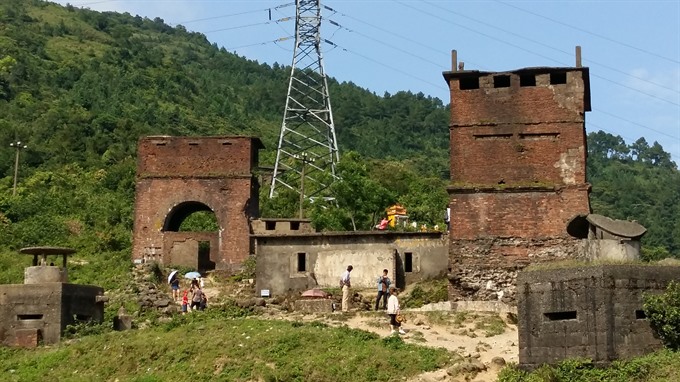Hải Vân Gate recognised as Historical Relic and Architecture
 |
| A complex of the Hải Vân Gate at 490m above sea level borders Đà Nẵng and Huế. - VNS Photo Công Thành |
The certificate was handed over to representatives of the two localities in a ceremony at the gate yesterday.
The Hải Vân Gate, situated on the top of Hải Vân Pass, is a complex of brick-built gates dating from the Trần Dynasty (1470), and octagonal bunkers from the French colonial period.
The gate is in poor condition due to prolonged disputes and a lack of co-ordination in management over the last two decades between Đà Nẵng and Thừa Thiên-Huế Province.
“It’s a landmark for the two localities in working together to preserve the historical relic on the most beautiful pass in central Việt Nam,” director of the Huế Monuments Conservation Centre Phan Thanh Hải told Việt Nam News.
“The two localities agreed to strengthen co-ordination for the prolonged preservation and restoration of the site,” he said.
Hải said the two localities will host scientific conferences on how to restore damaged items (stone walls, gates) and preserve current buildings (two bunkers and the concrete roof of the southern gate).
Deputy Minister of Culture, Sports and Department, Đặng Thị Bích Liên said the recognition showed the value of the relic.
She said it also showed the determination of the two localities in restoring the site.
Director of Thừa Thiên-Huế Provincial Culture and Sports Department, Phan Tiến Dũng said the relic is on the border of Lăng Cô Town in Thừa Thiên-Huế Province’s Phú Lộc District and Đà Nẵng’s Hòa Hiệp Bắc Ward in Liên Chiểu District.
He said the two localities will benefit from the site’s recognition as a national relic.
The relic, which has been left in ruins since Đà Nẵng separated from former Quảng Nam-Đà Nẵng in 1997, has been the centre of a long dispute between the two neighbouring localities.
Part of the foundations for the brick walls has eroded, the octagonal bunkers are covered in rubbish and people have vandalised the walls by writing on them.
A clay path that zigzags around the gates and the bunkers is surrounded by grass, bush and stones, and there are no information displays on the site’s history. There are only old inscriptions clearly visible on the arch, with small trees sprouting from the brick walls.
Despite its poor condition, the site attracts about 1,000 visitors per day who come on bikes and in vans from Huế and Đà Nẵng.
The site has coffee and souvenir shops, but there are no public toilets.
In 1997, the then Ministry of Culture and Information (now the Culture, Sports and Tourism Ministry) rejected recognising the site as a national relic, a request made by the administrations of both Thừa Thiên-Huế and Đà Nẵng due to the border controversy.
Research showed that 95 per cent of the site was in Thừa Thiên-Huế Province, while only a part of the old wall and a victory monument of the first garrison during the French War were fully within the Đà Nẵng border.
According to Hải, the two local bodies could not work on restoring the site as it was not entitled to ‘national-relic’ status.
What the stars mean:
★ Poor ★ ★ Promising ★★★ Good ★★★★ Very good ★★★★★ Exceptional
Latest News
More News
- Ba Ria-Vung Tau strengthens regional links to bolster tourism (November 04, 2024 | 10:00)
- Vietnam attracts growing interest from global travellers (October 28, 2024 | 17:59)
- Vietjet receives latest aircraft from Airbus in France (October 08, 2024 | 18:02)
- Telling travel stories through movies (October 08, 2024 | 14:00)
- South Korean tourists lead Vietnam’s tourism revival (October 08, 2024 | 11:49)
- Vietnam a golden land for golf tourism (October 08, 2024 | 11:41)
- Con Dao leads the way in circular tourism (October 08, 2024 | 08:00)
- Nestlé and VNAT announce new cooperation initiative (October 02, 2024 | 15:43)
- Hanoi recognises new city-level tourist areas (September 27, 2024 | 20:25)
- Hue to host 2025 National Tourism Year (September 19, 2024 | 15:13)




















 Mobile Version
Mobile Version